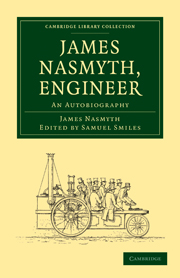Book contents
- Frontmatter
- PREFACE
- Contents
- ILLUSTRATIONS
- CHAPTER I MY ANCESTRY
- CHAPTER II ALEXANDER NASMYTH
- CHAPTER III AN ARTIST'S FAMILY
- CHAPTER IV MY EARLY YEARS
- CHAPTER V MY SCHOOL-DAYS
- CHAPTER VI MECHANICAL BEGINNINGS
- CHAPTER VII HENRY MAUDSLEY, LONDON
- CHAPTER VIII MAUDSLEY'S PRIVATE ASSISTANT
- CHAPTER IX HOLIDAY IN THE MANUFACTURING DISTRICTS
- CHAPTER X BEGIN BUSINESS AT MANCHESTER
- CHAPTER XI BRIDGEWATER FOUNDRY—PARTNERSHIP
- CHAPTER XII FREE TRADE IN ABILITY—THE STRIKE—DEATH OF MY FATHER
- CHAPTER XIII MY MARRIAGE—THE STEAM HAMMER
- CHAPTER XIV TRAVELS IN FRANCE AND ITALY
- CHAPTER XV STEAM HAMMER PILE DRIVER
- CHAPTER XVI NUREMBERG—ST. PETERSBURG—DANNEMORA
- CHAPTER XVII MORE ABOUT BRIDGEWATER FOUNDRY—WOOLWICH ARSENAL
- CHAPTER XVIII ASTRONOMICAL PURSUITS
- CHAPTER XIX MORE ABOUT ASTRONOMY
- CHAPTER XX RETIREMENT FROM BUSINESS
- CHAPTER XXI ACTIVE LEISURE
- CHRONOLOGICAL LIST OF INVENTIONS AND CONTRIVANCES
- SUN-RAY ORIGIN OF THE PYRAMIDS, AND CUNEIFORM CHARACTER
- INDEX
- Plate section
CHAPTER VI - MECHANICAL BEGINNINGS
Published online by Cambridge University Press: 10 November 2010
- Frontmatter
- PREFACE
- Contents
- ILLUSTRATIONS
- CHAPTER I MY ANCESTRY
- CHAPTER II ALEXANDER NASMYTH
- CHAPTER III AN ARTIST'S FAMILY
- CHAPTER IV MY EARLY YEARS
- CHAPTER V MY SCHOOL-DAYS
- CHAPTER VI MECHANICAL BEGINNINGS
- CHAPTER VII HENRY MAUDSLEY, LONDON
- CHAPTER VIII MAUDSLEY'S PRIVATE ASSISTANT
- CHAPTER IX HOLIDAY IN THE MANUFACTURING DISTRICTS
- CHAPTER X BEGIN BUSINESS AT MANCHESTER
- CHAPTER XI BRIDGEWATER FOUNDRY—PARTNERSHIP
- CHAPTER XII FREE TRADE IN ABILITY—THE STRIKE—DEATH OF MY FATHER
- CHAPTER XIII MY MARRIAGE—THE STEAM HAMMER
- CHAPTER XIV TRAVELS IN FRANCE AND ITALY
- CHAPTER XV STEAM HAMMER PILE DRIVER
- CHAPTER XVI NUREMBERG—ST. PETERSBURG—DANNEMORA
- CHAPTER XVII MORE ABOUT BRIDGEWATER FOUNDRY—WOOLWICH ARSENAL
- CHAPTER XVIII ASTRONOMICAL PURSUITS
- CHAPTER XIX MORE ABOUT ASTRONOMY
- CHAPTER XX RETIREMENT FROM BUSINESS
- CHAPTER XXI ACTIVE LEISURE
- CHRONOLOGICAL LIST OF INVENTIONS AND CONTRIVANCES
- SUN-RAY ORIGIN OF THE PYRAMIDS, AND CUNEIFORM CHARACTER
- INDEX
- Plate section
Summary
I left the High School at the end of 1820. I carried with me a small amount of Latin, and no Greek. I do not think I was much the better for my small acquaintance with the dead languages. I wanted something more living and quickening. I continued my studies at private classes. Arithmetic and geometry were my favourite branches. The three first books of Euclid were to me a new intellectual life. They brought out my power of reasoning. They trained me mentally. They enabled me to arrive at correct conclusions, and to acquire a knowledge of absolute truths. It is because of this that I have ever since held the beautifully perfect method of reasoning, as exhibited in the exact method of arriving at Q.E.D., to be one of the most satisfactory efforts and exercises of the human intellect.
Besides visiting and taking part in the works at Patterson's foundry, and joining in the chemical experiments at Smith's laboratory, my father gave me every opportunity for practising the art of drawing. He taught me to sketch with exactness every object, whether natural or artificial, so as to enable the hand to accurately reproduce what the eye had seen. In order to acquire this almost invaluable art, which can serve so many valuable purposes in life, he was careful to educate my eye, so that I might perceive the relative proportions of the objects placed before me.
- Type
- Chapter
- Information
- James Nasmyth, EngineerAn Autobiography, pp. 98 - 123Publisher: Cambridge University PressPrint publication year: 2010First published in: 1883



